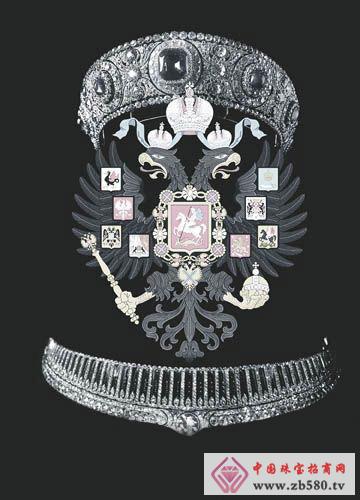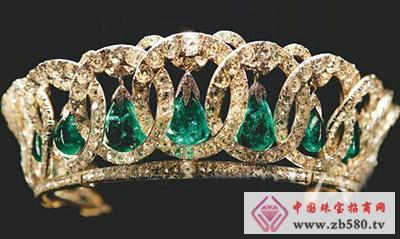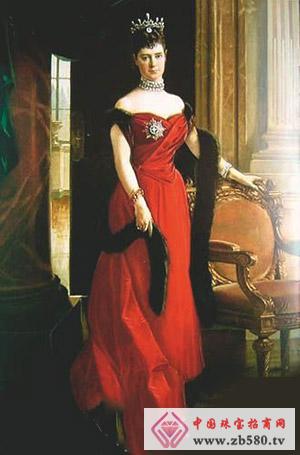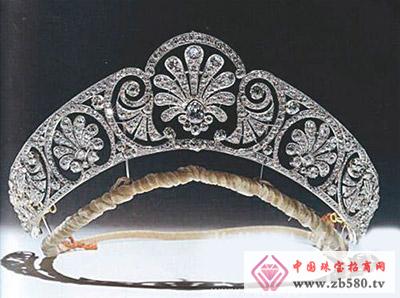Lead: The most favored country of the goddess of jewelry, non-Russian. On the land of this mysterious ice and snow empire, not only the vodka of the world's toon, but also the gold, amber, pearl, emerald, blue red and diamonds of the Ganges River are buried.

Russian jewelry
This is a magical country. Even if women are too poor to eat bread, they will still be proud to wear their mink coats, sparkling pearl necklaces and diamond necklaces, and go to the theater to watch a Nutcracker. After the disintegration of the former Soviet Union, the then US ambassador to Russia, F-Matlock, recalled this. In the two hundred and fifty years before him, the British princess Alice once wrote in a letter to her mother Victoria. Road: "The jewelry in the Tsar's palace, perhaps even your collection can not be compared. â€
Yes, Russian jewellery has always been the most mysterious and dazzling legend in the world. In this extremely northern country, often covered by ice and snow and night, the gleaming gem is light and hope. It bears witness to the heroic luxury of this legendary empire, and is also the glory of the eternal pride of the Russians.

Russian jewelry
Neva River flowing with gold and pearls
In 1744, a German girl named Sofia (002572) came to Moscow with a dusty skirt and was filled with disappointment with this dirty, poor and backward country. But as she struggled to climb the steps of the Kremlin from the sewage, she was suddenly dizzy by the dazzling gemstones on the glittering gold top of the church's spire and the bard lyre. Why can this ridiculous country accommodate such luxury and backwardness in such a dramatic manner? How can this rude nation be able to create romance and culture that is not inferior to the Italians?
Thirty years later, she has been honored as Ekaterina the Great and she found the answer. On that day, she wrote in her diary: "Cold and fertility are God's gifts. Even if the Russians are destined to dance only in the cold mud, the stones they fly in their boots must be even the Pope. The gem to be smashed."
Queen Ekaterina spent her life trying to make St. Petersburg a Paris in the Far East, and even the flowers under the rule of Napoleon and Louis XIV could not be compared with one-tenth of the St. Petersburg. That's right, even though the fashion beats of the Russian court are always behind the Palace of Versailles, the royal relatives of the Tsar are only envious of the gold and the jewels – who will put 3,000 diamonds in the Bible. On the cover? Who will use tons of gold to outline the pattern on the palace wall? Who would want to have afternoon tea in the whole amber-inlaid room? Who will use the malachite, jasper and agate that should have been embedded in the crown to lay the floor of the hall? So in London's social world, the topic of Russia is always so mysterious and tempting - this far north country has the world's richest gemstone veins, where women drink spirits while wearing purple coats, where poor shepherds I often don't have enough to eat, but as long as I pray to God, I often find the natural gold nuggets on the riverbank... and all the praises and sums are summed up in the end as a sigh: Oh, who is called Russia? ?
Yes, this is Russia, you don’t need to admire, but you can’t ignore it forever. In the mint green palace where the winter rose is clustered, the empress smiles proudly to the world. This smile is defined by eternal life as a Russian attitude towards jewelry: like, but never worship, because they are too rich, too Heroic.

Russian jewelry
This is a country that cannot be compared elsewhere. This is the country that Byron described as “the gold and pearls flowing in the Neva Riverâ€. So Russian men and women will love jewelry as simple and simple as they love fur, caviar and vodka: Cossack cavalry decorates their stables with gold, and textile girls put amethyst into their hair. The jewels of the Northland style are neither slender and detailed Rococo style, nor cold and sharp Gothic, but are transferred to the original ecology in the rich Baroque: thick and heavy bracelets, unpolished facets Gemstones, huge exaggerated crowns, simple and bright gemstones... elegant and barbaric, this is the unique saga of the Slavic people - and most women in the world are cheering for diamonds, Russia The men are worried about what they should use to please their fiancée: even a rock, it is easy to bring a generous gift of tens of billions of carats of diamonds to Russia. How can the proud Russian girls easily move their hearts?

Russian jewelry
The most vivid RussianStyle branding
From the beginning of the eighteenth century to the beginning of the twentieth century, Russian jewellery styles have repeatedly set off popular storms around the world for two hundred years. The ability of the Tsar's skilled craftsmen to influence the style of the entire jewelry world is beyond the imagination of most people.
If there is no Queen Catherine, the magical appeal of diamonds to women will undoubtedly be greatly reduced. Before 1725, the most fashionable diamond cutting method in Europe was still the old but not shining rose, which was derived from the strong demands of Ekaterina. The Italian diamond craftsman invented the diamond to reflect more. Multi-glossy brilliant cut.
There is no legendary master Fabergé, and the enamel and gold and silver filament inlays will not become the protagonists of modern jewellery art. In the long-term isolation, the Russians used the mosaic technology learned from the European continent in the early years to create treasures that are rare in the world. Today, Fabergé's hand-made Easter eggs have become one of the most brilliant legends in the history of jewelry. Those exquisite carvings, paintings and inlays are inexhaustible charms from any artistic point of view.
Without the demanding demands of the Russian nobility for the artistic creation of daily necessities, the ArtDéco trend could not be swept the world at the beginning of the last century. The peacock's self-timer bells, embroidered with emeralds and sapphires in the Winter Palace, and evening dresses woven with gold silk are recognized as the highest level of decorative art since the Renaissance. The Russians' love for chalcedony, amethyst and jasper promoted the European lady's pursuit of oriental style jewelry.
Even Louis Cartier himself admits that it is because of the influence of Russian jewellery that he will use rough geometric outlines and colorful symmetrical gemstones to define the most popular "Oriental style" in Cartier history - aristocratic women of the nineteenth century. The enthusiasm for the Kokoshnik-style crown comes from the crescent-shaped corolla of the Russian girl's costume. The elegant and dignified curve can accommodate more gems, which is undoubtedly the king of the night party. Still? Of course, if there is no unforgettable love with Russian Dagong Dimitri, how can CocoChanel create sophisticated designs with complex styles and complex levels? The pure white smog that rises on the Neva River and the shiny golden amber in the Baltic Sea have become her constant source of inspiration.
The feathers on the Cossack cavalry caps, the shining stars in the silent night sky of the Black Sea, all projected in the 1932 diamond jewelry series...
Yes, everything, thank you to Russia.

Russian jewelry
The swan song of abrupt end
There is only one kind of gem in the world that has the glory of the same name as the emperor, and that is Alexandrite, a gem named after Alexander the Great. This mysterious gem can be rendered in different colors in different shades of light, and is therefore called "the emerald in the day, the ruby ​​in the night". But nowadays, this gemstone, which is only produced in the Ural Mountains of Russia, has been exhausted. Just like the fate of the entire Russian jewellery, it has come to an abrupt end in the most colorful places and has become a resounding resounding in the sky.
The October Revolution replaced the arrogant double-headed scorpion with a sickle and an axe, and the stalwart Romanov dynasty disappeared in the dust of history at an incredible speed, leaving no trace. The former tsarist jeweler exiled to other countries, and the legendary empire jewellery that could be bought throughout Europe was not seen. Accompanied by these tragic legends is the nostalgia for Russian treasures - when the Russian style, which was originally scheduled to visit the winter snow monsoon, was suddenly cut off, the rich and the elite began to use the unprecedented interest to find the most dazzling of these empire. remains.
Most of the royal jewels flowed into the hands of the Tsar's European distant relatives - only the Empress Dowager Maria Fedorovna was lucky enough to escape the slaughter. The only immediate widow of the Russian royal family was a Danish princess who had to sell his jewels after exile. maintain lifehood. Queen Mary of the United Kingdom is her main patron, and many of the crowns and brooches of the British royal family can now be found in Russian royal portraits.
The jewels of the grandfather of Maria Pafrona were commissioned to the original designer Cartier for sale, including a crown decorated with seven sapphires (the largest one weighing 137.20 carats), one with grandmother The green feathers and a necklace with 39.25-carat pear-shaped diamonds were later sold to American celebrity Barbara Hutton and the royal family, replacing the bread and rent of the four children of Dagong.
American businessmen have a strong interest in Fabergé's Easter eggs, except for the 10 eggs left in Russia. Most of the 50 Easter eggs are collected by major museums in the United States. Forbes magazine owner Malcolm Stevenson-Forbes is undoubtedly the hero of these treasures. In 1960, he bought the Fabergé cigarette case for his wife to make a marriage anniversary, and bought an egg by the way. At that time, these little-known gadgets cost only $2,000. In the next 30 years, he purchased hundreds of Fabergé treasures including nine Fabergé royal eggs. It was under his introduction that the world gradually began to understand these Russian treasures that were silent in the corner of history. Today, the descendants of Fabergé have revived this smashed brand, and the auction price of the Tsar egg has soared to $200 million.
Just revisiting does not mean revival. Today, Russia is still a daunting power in the north, but the ingenuity and luxury inherent in Russian jewellery are hard to be re-enacted. Emerging Russian jewellery designers such as IlgizF have either emphasized the grandeur's grandeur and wealth, or are more fascinated by alternative artistic expressions. Perhaps, the dreamy Russian jewellery is only a dream, and it is destined not to exist in the world for a long time.
Womens Knitwear,Womens Chunky Knit Cardigan,Pure Wool Sweaters For Ladies,Black Jumper Womens
SHAOXING NEWIDEA GARMENT CO.,LTD , https://www.shouyaoapparel.com